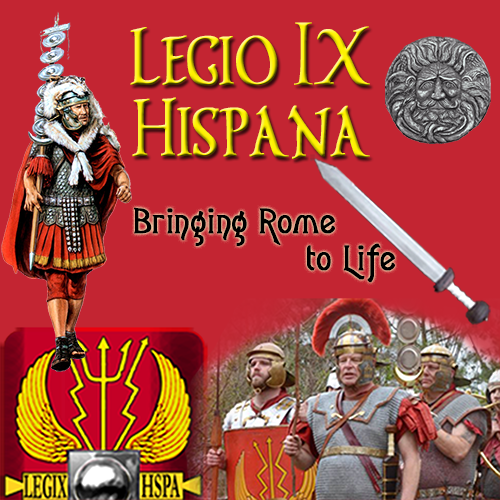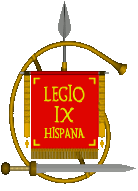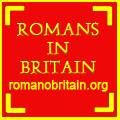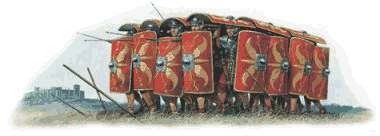Scutum (shield)
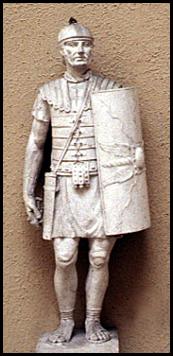
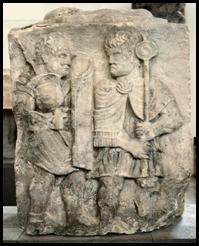 As scuta
(pl. for scutum) go, most Roman reenacting units interpret this as a
rectangular shield that is made in a tubular shape. This being said, no one has actually found one,
except from the 3rd Century site at Dura Europos... what does that mean? Well, using statuary like Trajan's
Column and the "Mainz Pedestals" from the Roman fortress of Mainz-Kästrich (which are
now in the Landesmuseum), reenactor's (>and scholarly types) have extrapolated the "standard" 1st
century rectangular scutum. Some, like armorer ( ">and Roman artisan)
Matt Lukes, feel that the scutum corners were more likely not radiased, but instead squared off. Matt also tells me
that he believes scuta were not painted in the "mono-colour" patterns most reenactors use, but
instead, more likely as done on the Dura Europas shield. This could be born out because the only original
Vexillum is done the same way, along w/ a couple of partial other shields from the Dura find. Hmmmm....
"Blasphemy, Mr. Wise, Blasphemy!"
As scuta
(pl. for scutum) go, most Roman reenacting units interpret this as a
rectangular shield that is made in a tubular shape. This being said, no one has actually found one,
except from the 3rd Century site at Dura Europos... what does that mean? Well, using statuary like Trajan's
Column and the "Mainz Pedestals" from the Roman fortress of Mainz-Kästrich (which are
now in the Landesmuseum), reenactor's (>and scholarly types) have extrapolated the "standard" 1st
century rectangular scutum. Some, like armorer ( ">and Roman artisan)
Matt Lukes, feel that the scutum corners were more likely not radiased, but instead squared off. Matt also tells me
that he believes scuta were not painted in the "mono-colour" patterns most reenactors use, but
instead, more likely as done on the Dura Europas shield. This could be born out because the only original
Vexillum is done the same way, along w/ a couple of partial other shields from the Dura find. Hmmmm....
"Blasphemy, Mr. Wise, Blasphemy!"
Size
 There are many
options for scutum
size, shape, and materials. The common shape in the mid-first century seems to have been rectangular, but
the curve-sided "Augustan" style is still seen on Trajan's Column. The height ranges from 37"
to 42", about from the shoulders to the top of the knee, and the width is 24" to 33". The
corners are typically rounded, but square corners are easier for a leather rim or a rimless shield.
There are many
options for scutum
size, shape, and materials. The common shape in the mid-first century seems to have been rectangular, but
the curve-sided "Augustan" style is still seen on Trajan's Column. The height ranges from 37"
to 42", about from the shoulders to the top of the knee, and the width is 24" to 33". The
corners are typically rounded, but square corners are easier for a leather rim or a rimless shield.
Anyway, if one looks at these accompanying photos, you can see the scutum DID wrap around and WAS rectangular... did it have radiased corners? You decide.
Our Interpretation
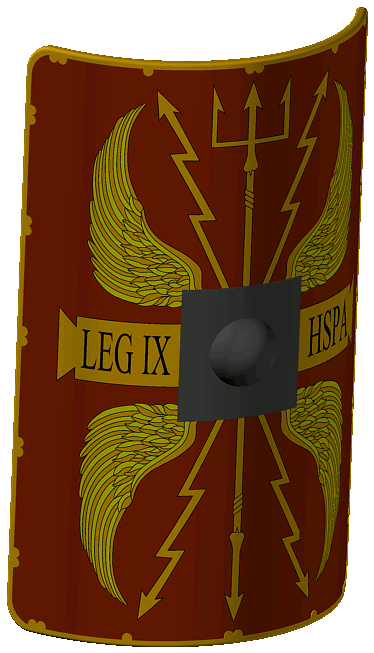 The scutum (pl. scuta) as interpreted and
used by Legio IX, is a curved rectangle, with rounded corners, in imitation of the archaeology related
to the Vindonissa and Doncaster scutum cover finds. The scutum is edged in bronze, brass or leather
(rawhide or vegetable-tanned).
The scutum (pl. scuta) as interpreted and
used by Legio IX, is a curved rectangle, with rounded corners, in imitation of the archaeology related
to the Vindonissa and Doncaster scutum cover finds. The scutum is edged in bronze, brass or leather
(rawhide or vegetable-tanned).
he scutum can be covered either with linen or leather which is then painted with a device composed of: 2 sets of wings; 2 lightning bolts transversing the scutum diagonally; a 2 part horizontal tabula with Legio abbreviation and lastly, a vertical trident.
The scutum has a rectangular domed umbo ("shield boss). The umbo can be either brass, bronze or iron, with, or without decoration.
The back will have reinforcing strips (">of sawn wood or half round), covered by linen and a hardwood handgrip.

Back view of scutum under construction.
(photo courtesy of
M. Favonivs Arcanvs.)
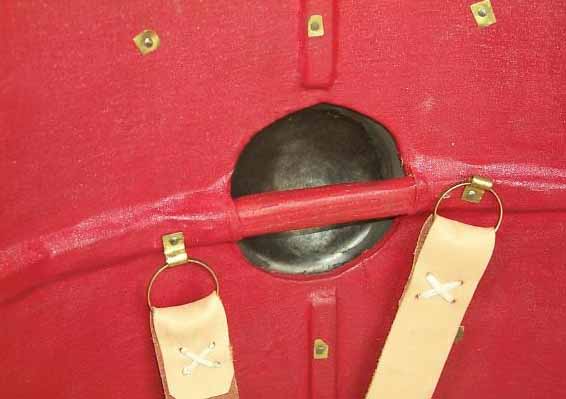
Detail view of scutum grip
(photo courtesy of Leg. XX, MD.)

Structure
The scutum was an approximately 10kg large oval curved shield made from two sheets of wood glued together and covered with linen-canvas and leather. The best surviving example, (once again, the one from Dura-Europos in Syria), was 1.06m (42") in height, with a chord of 0.66 m (26"), and a distance around the curve of 0.86 m (34"), and a thickness of 5 mm to 6 mm.
So, with this in mind, we should try to emulate this model. We have found though, that a lighter shield, obviously, is easier to carry and in some cases, might be better for our impressions. Stay tuned there.
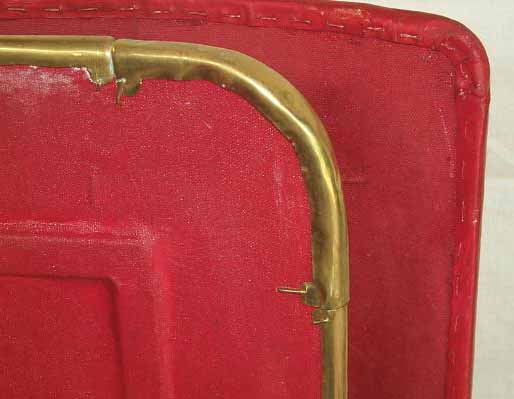
Detail views of scutum
rim construction
(photo courtesy of
Leg. XX, MD.)
Advantages and Disadvantages.
The Roman Scutum is light enough to be held in one hand and its height and width gave good cover to the wielder, making him less likely to get hit by missile fire and in hand-to-hand combat. The metal umbo,or boss, in the center of the scutum also made it an auxiliary punching weapon as well. The composite construction meant that early versions of the scutum could fail from a heavy cutting or piercing blow which was experienced in the Roman Campaigns against Carthage and later, in Dacia, where the Falx and Falcata could easily penetrate and rip through the scutum. The effects of these weapons prompted design changes that made the scutum more resilient such as thicker planks and metal edges.

When compared to the earlier aspis which it replaced, the aspis was heavier and provided less protective coverage than the scutum but was much more durable.
Combat uses
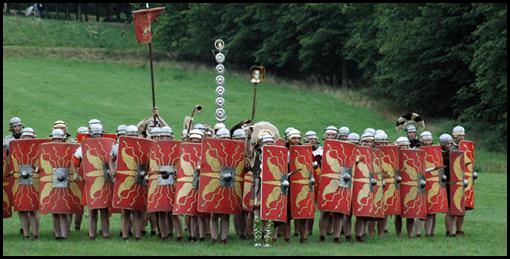
Left: Reenactment of an early imperial legionary shield array.
According to Polybius the scutum gave Roman soldiers an edge over their Carthaginian enemies during the Punic Wars: "Their arms also give the men both protection and confidence owing to the size of the shield."
The Roman writer Suetonius recorded an anecdote of the heroic centurion Cassius Scaeva, who fought under Caesar in the Battle of Dyrrachium:
Suetonius: ...with one eye gone, his thigh and shoulder wounded, and his shield bored through [with arrows] in a hundred and twenty places, [he] continued to guard the gate of a fortress put in his charge... [he] boarded the ship and drove the enemy before him with the boss of his shield.'
The Roman writer Cassius Dio in his Roman History described Roman against Roman in the Battle of Philippi:
Cassius Dio: For a long time there was pushing of shield against shield and thrusting with the sword, as they were at first cautiously looking for a chance to wound others without being wounded themselves.
The shape of the scutum allowed packed formations of legionaries to overlap their shields to provide an effective barrier against missiles. The most novel and well-known (and specialized, for it afforded negligible protection against other attacks) use was the testudo (">Latin for "tortoise"), which added legionnaires holding shields from above to protect against descending missiles (such as arrows or objects thrown by defenders on walls).
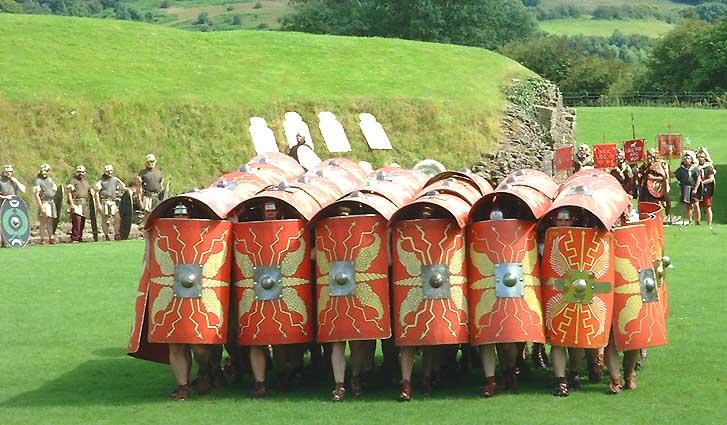
The testudo performed at a show in the UK, as used during a siege, just as seen on Trajan's Column. Note the wing and thunderbolt motifs on the scuta.
Dio gives an account of a testudo put to good use by Marc Antony's men while on campaign in Armenia:
Cassius Dio: One day, when they fell into an ambush
and were being struck by dense showers of arrows, [the legionaries] suddenly formed the
testudo by joining their shields, and rested their left knees on the ground.
The barbarians... threw aside their bows, leaped from their horses, and drawing their
daggers, came up close to put an end to them. At this the Romans sprang to their feet,
extended their battle-line... and confrontin the foe face to face, fell upon them...
and cut down great numbers.
However the testudo was not invincible, as Dio also gives an account of a Roman shield array being defeated by Parthian knights and horse archers at the Battle of Carrhae:
Cassius Dio: For if [the legionaries] decided to lock shields for the purpose of avoiding the arrows by the closeness of their array, the [knights] were upon them with a rush, striking down some, and at least scattering the others; and if they extended their ranks to avoid this, they would be struck with the arrows.
Special uses
Cassius Dio describes scuta being used to aid an ambush:
Cassius Dio: Now Pompey was anxious to lead Oroeses into conflict before he should find out the number of the Romans, for fear that when he learned it he might retreat... he kept the rest behind... in a kneeling position and covered with their shields, causing them to remain motionless, so that Oroeses should not ascertain their presence until he came to close quarters.
Dio also notes the use of the scutum as a tool of psychological warfare during the capture of Syracuse:
Cassius Dio: Accordingly some of the gates were opened by [legionaries], and as soon as a few others had entered, all, both inside and outside, at a given signal, raised a shout and struck their spears upon their shields, and the trumpeters blew a blast, with the result that utter panic overwhelmed the Syracusans.
In 27 BC the emperor Augustus was awarded a golden shield by the Senate for his part in ending the civil war and "restoring" the Republic, according to the Res Gestae Divi Augusti. The shield, the Res Gestae says, was hung outside the Curia Julia, serving as a symbol of the Princeps' "valour, clemency, justice and piety."
The 5th century writer Vegetius added that scuta helped in identification:
Vegetius: Lest the soldiers in the confusion of battle should be separated from their comrades, every cohort had its shields painted in a manner peculiar to itself. The name of each soldier was also written on his shield, together with the number of the cohort and century to which he belonged.
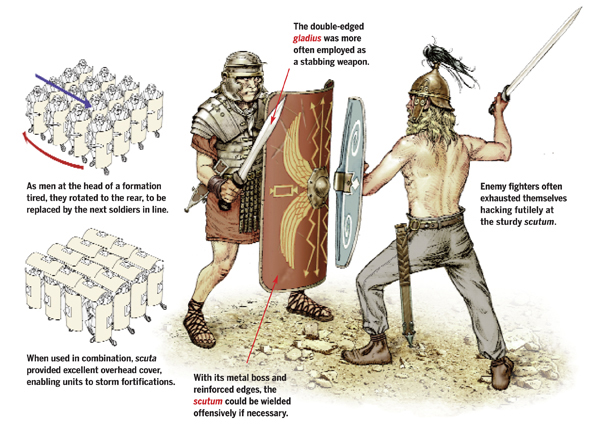
However since Vegetius was not a military man and his works ( for example De Re Militari) freely, anachronistically mixed the present with the dim and distant past, we must take his descriptions with a grain of salt. Shields in Vegetius' day were used to distinguish between units, but, contrary to his claim here, there is little evidence that this was true of the earlier Empire.
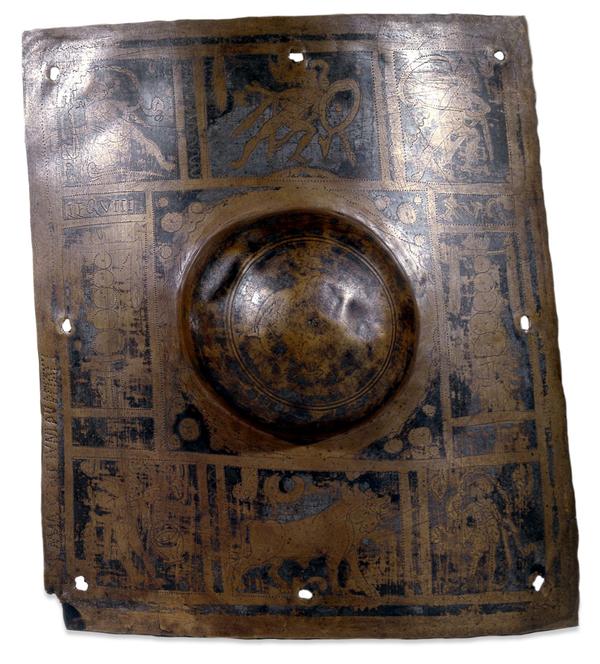
Above, is a photo of one of the very few umbos of this type.
A detailed, nicely-done highly decorated model.
(Photo courtesy of the British Museum).
 Drawing to the right >>> is same umbo as above... maybe a little clearer in some respects... Was this a common thing? We don't know. There
haven't been that many umbos found.
Drawing to the right >>> is same umbo as above... maybe a little clearer in some respects... Was this a common thing? We don't know. There
haven't been that many umbos found.

